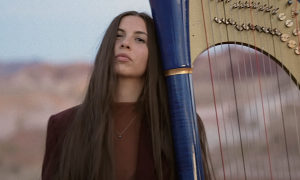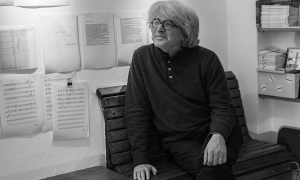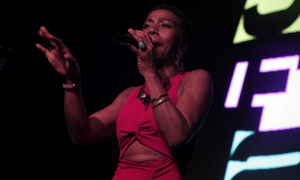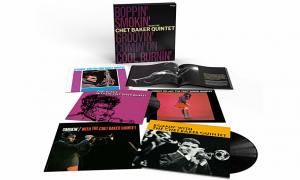Home » Jazz Articles » Interview » Laura Jurd: Big Footprints
Laura Jurd: Big Footprints
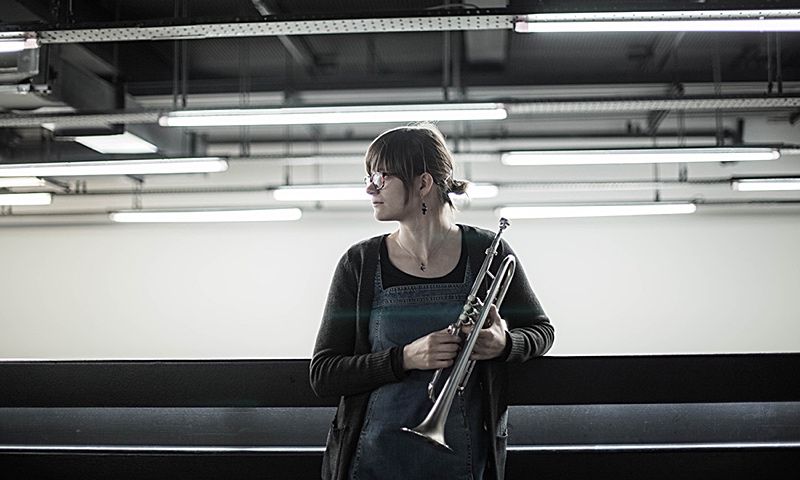
It’s difficult to describe, but I always find it such an exciting thing about art in general–the whole universal language thing that it achieves and the way it can connect a bunch of strangers in a room.
—Laura Jurd
A new group? Well, not entirely. Jurd, Elliot Galvin, Conor Chaplin and Corrie Dick have been together since 2010, going under the name of the Laura Jurd Quartet. After one critically acclaimed album and six years gigging and building a musical identity, it seemed like an odd move, not to say a risky one, to change the band's name.
"A lot of the bands that I love—none of them are called the so-and-so Quartet," explains Jurd. "Because of the direction the music was heading in, and because it feels like such a band and not a fleeting project, I just didn't feel it was right anymore to call it that [Laura Jurd Quartet] anymore, though I'm sure I will do projects in the future under my own name."
The name Dinosaur and its music had been fermenting in Jurd's mind for some time. "I had this band called Dinosaur in my head, which was electric, a bit rocky, and way in the future. The music we were playing started to turn into that and I started thinking, maybe this funny little fantasy band I have in my head is actually my band," Jurd laughs. "Definitely we had to make a decision about the name before recording an album because once you've made an album as a band that's it."
Under the former LJQ moniker, the quintet recorded one album, 2012's Landing Ground (Chaos Collective), which featured Jurd's original writing for the quartet and the Ligeti String Quartet, plus Jurd's duets with cello, piano and drums. The music on Together, As One, however, is markedly different, almost as if a different band were behind the music.
"When we were making this album I had gone really deep into a lot of those 1970's Miles Davis albums, Jurd relates. "It's just where my head is at the moment. I love albums like Live Evil (Columbia, 1971) Jack Johnson (Columbia, 1971), Bitches Brew (Columbia, 1970), On the Corner (Columbia, 1972). I love listening to how Miles plays on those albums and how they develop the grooves. That's definitely a big influence," acknowledges Jurd.
"I think the trumpet, as an acoustic instrument, works so wonderfully with that electric sound, and the percussive element of the trumpet works really well in that setting. The amazing thing about all the decades of Miles' career is that they are each brilliant in their own way. I always ask myself what my desert island disc would be and if I could only take one—and it's a horrible question for me—but I think Bitches Brew would definitely be up for consideration."
Listening to Dinosaur's Together, As One, whether it be Jurd's searing trumpet lines or Elliott Galvin's Fender Rhodes/Hammond organ textures, and the Davis connection is perhaps a little obvious. Scratch just a little below the surface, however, and there are plenty of other influences at play as well, from minimalism to contemporary classical music, and from European folk elements to Scandinavian cool.
"I think it's an inevitability because of a lot of the music I've listened to," says Jurd of these influences. "I really love a lot of minimalism—Steve Reich is a big influence on me, so I can definitely hear some of that in places on the album. Yeah, harmonically sometimes it comes from a less jazzy world. There's Rhodes on a piece which is probably quite influenced by the likes of John Tavener and Arvo Part , and maybe Stravinsky as well—all kinds of things, I guess, but they're the main things that come to mind from a non-jazz world."
For Jurd, however seemingly disparate the sources of inspiration may seem, it's all part of the same musical melting pot for the twenty six year-old trumpeter. "Classical music is as much an influence on me as jazz music, whether it's with Dinosaur or a string quartet or an orchestra, or whatever. I'm just trying to find a way to include improvising musicians and to bring all my influences together, I guess."
Though Davis is her current muse, it was another jazz trumpeter that first sparked Jurd's imagination. "I really got into jazz listening to a lot of Chet Baker," she says. "I also really love the Italian trumpet player Enrico Rava. I went through a period of being really obsessed with his albums. I think he's perhaps very influenced by the way Miles plays. He's very different but he has a great sound. Later on I got into some Norwegian trumpet players like Arve Henrikksen and Mathias Eick."
The second track on Together, As One, "Robin," begins with a keyboard intro from Elliot Galvin that has the distinctive feel and clarity of an English folk song. "I have to say I'm a bit of a philistine when it comes to folk music," admits Jurd, "however, I'm very draw to the sounds of it. For some reason those English and Celtic folk sounds really resonate with me. I also like a lot of British twentieth century classical composers like Benjamin Britten and Michael Tippett. They are really huge influences and quite life changing. It probably rubs off."
The music that would become Together, As One evolved over time, though there were already signs of the direction Jurd wanted to take when the group performed in Dublin—as the LJQ—at 12 Points 2015.
"We didn't play any of the music from Together, As One at 12 Points, but we were certainly heading in that direction," Jurd explains. "The music at 12 Points was music I wrote for the band just before the Together, As One music. It was almost there but not quite right. I ended up not wanting to record any of that music. It was part of a process but it didn't make the cut," she laughs. "But we did a short tour of just three or four dates to play the music before we recorded it."
For this new album, Jurd and Dinosaur were picked up by Edition Records, one of the fastest rising and most progressive European labels specializing in jazz/related music and classical music. In just a few short years Edition has released high quality, beautifully produced recordings by the likes of Girls in Airports, Thomas Gould, Tim Garland, Oddarrang, Daniel Herskedal, Verneri Pohjola, Phronesis, Morten Schantz, Eyolf Dale and Alexi Tuomarila, to name but a handful.
Clearly, the move to such an ambitious, professional label was a good one. "It's been really brilliant to be part of a label with such great artists and the timing of it all worked really well," says Jurd, "because I was just starting to think about the Dinosuar album and when I was going to release it. I was pretty sure I didn't want to self-release again because I didn't feel I could do it justice."
Happily, Edition Records' head Dave Stapleton was interested in recording Dinosaur. "Everything seemed to fall into place," says Jurd, who is full of praise for Stapleton and the Edition team. "I was very happy to work very closely with Dave, also in terms of the artwork and the presentation of it—all the press, which really gave the album such a boost. I don't think I could have achieved that doing it alone," Jurd admits. "I have a lot of admiration for just how hard Dave works. It's pretty incredible what he's achieved against all the odds. It takes a lot of persistence."
The same could be said of Jurd and her colleagues in Dinosaur. The four musicians met while studying music at Trinity College of Music [now called the Trinity Laban Conservatoire of Music and Dance]. "Elliot [Galvin] and I were in the same year, Connor [Chaplin] and Corrie [Dick] in the year below, so we all crossed paths immediately. I actually knew Connor a year or so before the other guys because we went to the same Sixth Form College," Jurd explains.
"Upon hearing each of them I was immediately struck by their individuality—real musicianship from each player. We were all about nineteen when we started out. It was very serendipitous. That I stumbled across the band that I feel good about, both on a social and musical level, at such an early age and for it to just work is just really luck. I feel really lucky."
All four musicians are involved in various projects. Galvin leads his own group, whose two recordings as leader in his own right, Dreamland (Chaos Collective, 2015) and Punch (Edition Records, 2016), have both received general critical acclaim; Chaplin and Dick are both in demand in a wide variety of settings. Yet despite the pull of outside opportunities, Dinosaur is in no danger of becoming extinct any time soon. "I think the other guys think of Dinosaur as a big part of their lives," says Jurd. "We manage to plan everything well in advance and it works somehow. We're in our seventh year now, which is pretty cool."
Jurd too, is much sought after as both an improviser and as a composer. In 2015 the trumpeter became a BBC3 New Generation Artist, a two-year residency program awarded to promising young artists. "Over the course of those two years you have various opportunities, the main thing being quite a lot of radio broadcasts, perhaps more concentrated than normal," explains Jurd. "There are opportunities to record and broadcast with whoever you like really, and do projects of your choice. During the London Jazz Festival [2016] I wrote a piece for the BBC Concert Orchestra, which was a great opportunity. That was with Dinosaur."
The support of the BBC 3 New Generation Artist scheme has extended beyond raising Jurd's profile via national radio. "They also helped to make the album happen," continues Jurd. "They helped fund some of the album, which was a really great help at the time. It helped us make a really nice job of it in terms of the mixing and mastering."
With Jurd involved as a BBC 3 New Generation Artist throughout the remainder of 2017 there are still, she says, a few more things in the pipeline. "Dinosaur is playing a concert at the Wigmore Hall in July, which is also part of that scheme. We're going to play acoustically for that, so it's going to be a slightly different concert to our usual ones."
Jurd's potential was spotted early on in her career. In 2013 she she was invited to participate in Take Five, a program run by Serious -producers of the London Jazz Festival—to encourage and help the UK's most promising young jazz musicians to develop their careers. Martel Ollerenshaw, head of Serious' Take Five program described Jurd as "a precocious talent." She wasn't alone in that assessment. Pete Churchill, Director of the London Vocal Project, clearly agrees. When he was looking for a trumpeter for a tribute to the late Kenny Wheeler at the Bray Jazz Festival 2015, the first name that came to his mind was that of Laura Jurd.
The Wheeler tribute at Bray Jazz Festival 2015 brought together The Dublin City Jazz Orchestra with Jurd and Lauren Kinsella (Jurd playing Wheeler to Kinsella's Norma Winstone) in a heartfelt interpretation of Wheeler's The Sweet Time Suite -a performance that was a highlight of the festival.
Jurd has unreserved admiration for Wheeler. "The first time I heard Kenny I was really blown away—so beautiful. As a player he's pretty unique. I think that anyone who has such a unique and identifiable sound it's very admirable. He's an amazing trumpet player, technically brilliant and really inspiring. I saw him play a couple of times when he was older and he was still amazing."
Yet in spite of the esteem in which she holds the late Canadian/British trumpeter, Jurd doesn't think Wheeler has overtly influenced her own approach to playing. "I love listening to his music a lot, and his compositions, but I'm not sure how much they find themselves into my own writing. His compositions are a language of their own and in a way untouchable for me. As much as I love it I have a certain threshold for it because it's such a strong-sounding thing. I have to have a bit of a break from that sound some times."
Jurd and Kinsella have played together on numerous occasions throughout the UK and internationally, notably in the art-rock combo Blue Eyed Hawk, whose debut Under The Moon (Edition Records, 2014) and riveting live shows heralded the arrival of a special band. Blue Eyed Hawk, however, seems to have parked up indefinitely on the hard shoulder. "It's a bit of a shame really," laments Jurd. "Just as we were starting to do lots of exciting things it's not really a thing anymore. That's where Lauren and I played together, so it's sad. I'm hoping to play with her again soon actually. I don't know in what setting but I really love the trumpet-voice setting. She's really fun to improvise with."
Jurd, however, recognizes that any project has a natural lifespan. One significant project that has perhaps run out of steam is the Chaos Collective. Set up under Jurd's initiative while still at Trinity College, this loose collective of improvisers ran residencies first at Vice and then at The Vortex. "It was a chance to put on double bills and triple bills and showcase all the music we were writing and the bands that we had, so it was a nice platform for us to perform—one we all helped create," explains Jurd.
Chaos Collective also recorded some of those bands, including the Laura Jurd Quartet's 2012 debut, Landing Ground, Jurd's remarkable solo album, Human Spirit (Chaos Collective, 2015) and a big-band album by the Chaos Orchestra, Island Mentality (Chaos Collective, 2014). "The Chaos Collective was a really great thing to do at the time because it helped to unify a scene of musicians," Jurd explains. "It created an identity for all of us and perhaps we wouldn't be doing what we're doing today if we hadn't started all those things. Perhaps run its course in some ways, because we're all very busy doing all kinds of things and if you can't give something one hundred per cent then maybe it's natural to let it go. A lot of these things start when people are younger, when there are fewer adult responsibilities and life is slightly less complicated."
As Jurd's reputation has grown, various doors of opportunity have opened. In 2015 Jurd was commissioned to write music for the Hampshire County Brass Band and the Hampshire County Youth Orchestra, for an event held at the Royal Albert Hall that attracted school groups from all corners of the UK. "The pieces of music I wrote were very short," says Jurd, "but I ended up recycling one of them on the Dinosaur album, actually. That's the piece "Steadily Sinking," which is like a short connecting piece." Jurd has just finished writing another piece for the Hampshire County Youth Brass Band and clearly relishes connecting with, and inspiring, the up-and-coming generation.
Jurd achieves such connections on a more regular basis through her educational role -a responsibility that she doesn't take lightly. "It's a really, really important thing for me," she stresses. "I teach composition from beginner to quite advanced level at Trinity Laban, where I studied, which is great. The reason I love teaching is because I feel so close to being a student myself; I still am in a way. The reason I do what I do today is because of the amazing teachers I grew up studying with. Having had completely inspiring teaching I realize its value. Music education done in the right way can be a super-powerful thing."
On the subject of female role models Jurd cites Carla Bley, Bjork and Judith Weir, although female trumpet players are thin on the ground. As jazz celebrates its first centenary, the disparity between male and female jazz musicians is not quite as pronounced as it was in the past. More and more young women are, like Jurd, leading bands, writing outstanding music and taking care of business. Jurd is part of a generation of female jazz practitioners that arguably doesn't suffer anything like the sort of barriers and prejudices that previous generations of women jazzers faced.
"I think I'd agree with that, even just from a societal point of view," says Jurd. "In all parts of society I think we're seeing this change, whether it's in the world of jazz or the world of finance or whatever. Definitely in teaching I notice more and more young females getting into jazz and also into composition. You see more and more all-female orchestras now. I think it's evolving naturally, as it is in society. It's more normal for women to make those kind of career choices."
It will be fascinating to see what career choices Jurd makes in the future as her musical horizons expand and further opportunities present themselves. For the time being though, her main focus is on Dinosaur, which is beginning to play an increasing number of concerts abroad. "It's really exciting to have new audiences hear the music," enthuses Jurd. "It's a really refreshing position to be in. In the UK there's only a certain amount of people that we can really reach. Any chance to increase the amount of people who enjoy the music is a good thing."
On the inside cover of Together, As One Jurd pens a line that says a lot about her desire to genuinely share her music. 'This music now belongs to no-one... I absolutely love it when music does that.' Jurd explains: "By the time music is written, and I guess you could say the same thing about the visual arts too, then it no longer belongs to the creator because of how it's received, whether by people playing it, or people experiencing it in the audience. It's a completely individual thing. It's difficult to describe, but I always find it such an exciting thing about art in general—the whole universal language thing that it achieves and the way it can connect a bunch of strangers in a room. It's super exciting and one of the reasons I love it very much."
Photo Credit: Courtesy of Laura Jurd/Edition Records
Tags
PREVIOUS / NEXT
Support All About Jazz
 All About Jazz has been a pillar of jazz since 1995, championing it as an art form and, more importantly, supporting the musicians who make it. Our enduring commitment has made "AAJ" one of the most culturally important websites of its kind, read by hundreds of thousands of fans, musicians and industry figures every month.
All About Jazz has been a pillar of jazz since 1995, championing it as an art form and, more importantly, supporting the musicians who make it. Our enduring commitment has made "AAJ" one of the most culturally important websites of its kind, read by hundreds of thousands of fans, musicians and industry figures every month.



















